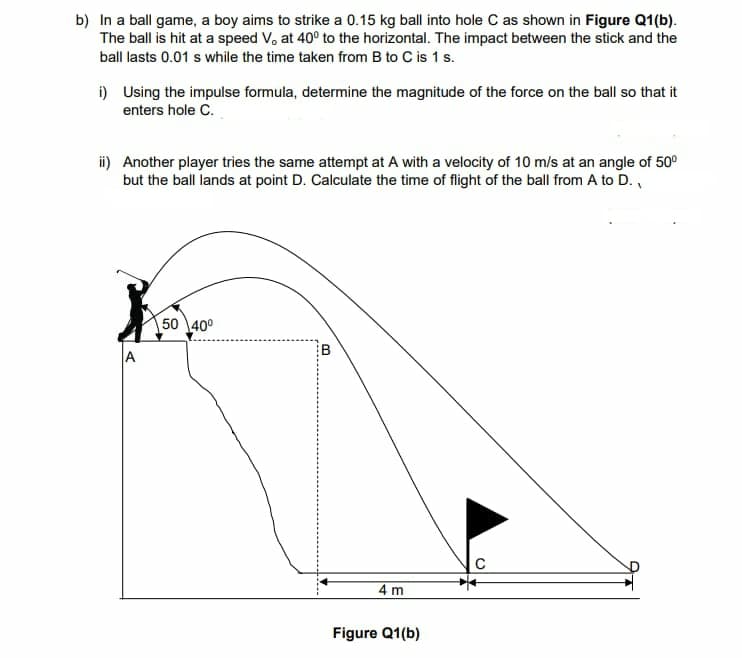b) In a ball game, a boy aims to strike a 0.15 kg ball into hole C as shown in Figure Q1(b). The ball is hit at a speed V, at 40° to the horizontal. The impact between the stick and the ball lasts 0.01 s while the time taken from B to C is 1 s. i) Using the impulse formula, determine the magnitude of the force on the ball so that it enters hole C. ii) Another player tries the same attempt at A with a velocity of 10 m/s at an angle of 50⁰ but the ball lands at point D. Calculate the time of flight of the ball from A to D., 50 40⁰ A 3 4 m Figure Q1(b) C
b) In a ball game, a boy aims to strike a 0.15 kg ball into hole C as shown in Figure Q1(b). The ball is hit at a speed V, at 40° to the horizontal. The impact between the stick and the ball lasts 0.01 s while the time taken from B to C is 1 s. i) Using the impulse formula, determine the magnitude of the force on the ball so that it enters hole C. ii) Another player tries the same attempt at A with a velocity of 10 m/s at an angle of 50⁰ but the ball lands at point D. Calculate the time of flight of the ball from A to D., 50 40⁰ A 3 4 m Figure Q1(b) C
Principles of Physics: A Calculus-Based Text
5th Edition
ISBN:9781133104261
Author:Raymond A. Serway, John W. Jewett
Publisher:Raymond A. Serway, John W. Jewett
Chapter8: Momentum And Collisions
Section: Chapter Questions
Problem 64P: Sand from a stationary hopper falls onto a moving conveyor belt at the rate of 5.00 kg/s as shown in...
Related questions
Question
Read the question carefully and give both right solutions with clear calculations.

Transcribed Image Text:b) In a ball game, a boy aims to strike a 0.15 kg ball into hole C as shown in Figure Q1(b).
The ball is hit at a speed V, at 40° to the horizontal. The impact between the stick and the
ball lasts 0.01 s while the time taken from B to C is 1 s.
i) Using the impulse formula, determine the magnitude of the force on the ball so that it
enters hole C.
ii) Another player tries the same attempt at A with a velocity of 10 m/s at an angle of 50⁰
but the ball lands at point D. Calculate the time of flight of the ball from A to D.,
K
A
50 40⁰
3
4 m
Figure Q1(b)
C
Expert Solution
This question has been solved!
Explore an expertly crafted, step-by-step solution for a thorough understanding of key concepts.
Step by step
Solved in 3 steps with 3 images

Knowledge Booster
Learn more about
Need a deep-dive on the concept behind this application? Look no further. Learn more about this topic, physics and related others by exploring similar questions and additional content below.Recommended textbooks for you

Principles of Physics: A Calculus-Based Text
Physics
ISBN:
9781133104261
Author:
Raymond A. Serway, John W. Jewett
Publisher:
Cengage Learning

Physics for Scientists and Engineers with Modern …
Physics
ISBN:
9781337553292
Author:
Raymond A. Serway, John W. Jewett
Publisher:
Cengage Learning

Physics for Scientists and Engineers, Technology …
Physics
ISBN:
9781305116399
Author:
Raymond A. Serway, John W. Jewett
Publisher:
Cengage Learning

Principles of Physics: A Calculus-Based Text
Physics
ISBN:
9781133104261
Author:
Raymond A. Serway, John W. Jewett
Publisher:
Cengage Learning

Physics for Scientists and Engineers with Modern …
Physics
ISBN:
9781337553292
Author:
Raymond A. Serway, John W. Jewett
Publisher:
Cengage Learning

Physics for Scientists and Engineers, Technology …
Physics
ISBN:
9781305116399
Author:
Raymond A. Serway, John W. Jewett
Publisher:
Cengage Learning

College Physics
Physics
ISBN:
9781938168000
Author:
Paul Peter Urone, Roger Hinrichs
Publisher:
OpenStax College

Physics for Scientists and Engineers: Foundations…
Physics
ISBN:
9781133939146
Author:
Katz, Debora M.
Publisher:
Cengage Learning

College Physics
Physics
ISBN:
9781305952300
Author:
Raymond A. Serway, Chris Vuille
Publisher:
Cengage Learning